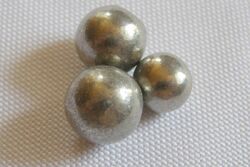
3 nickel spheres made by the Mond process. Author: René Rausch.

Hydroxid nikelnatý - Ni(OH)2. Author: Ondřej Mangl.
Overview[]
Whist it may seem strange to connect a metal with the Cold War, but it is non the less connected in it's own unusual way, as do all fuels, phosphates, metals and metal ores. This is why the world obsessed about winning over or capturing many obscure African, Central American, Caribbean and Asian nations.
Oil, coal, gas, gold, silver, platinum, frakable oil, diamonds, uranium and diamonds are more famous, but potash, salt, bauxite, talc, clay, kaolite, quarry stone, oil shales and other minerals are also major national assets.
The hard and silver-grey metallic chemical element called nickel is classed as a transition metal. Nickel was formally discovered to be an element by Axel Cronstedt in the 1750s and has been used as far back as circa ~5,000BCE for some Egyptian funeral artefacts.
Uses[]
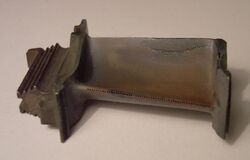
Nickel super-alloy jet engine (RB199) turbine blade. Used turbine blade of RR 199.
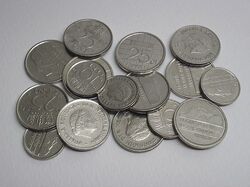
Dutch coins made of pure nickel.
Nickel has many wide spread uses and is used in many specific and recognizable industrial and consumer products. These products including stainless steel, alnico magnets, coinage, rechargeable batteries, electric guitar strings, nickel jet engine turbine blade super-alloy used in the Turbo-Union RB199 aircraft turbofan jet engine, nickel aluminide, some types of batteries, thermostat elements, microphone capsules, coinage, magnets, electroplating metal coat zips, electroplating potato chip-frying baskets and special alloys.
Nickel is used in alloys for ship's propellers, gold rings and metal oarlock's on row-boats.
Nickel is used as a binder in the cemented tungsten carbide or hard-metal industry and nickel foam or nickel mesh is used in gas diffusion electrodes for alkaline fuel cells. Parts of the North American X-15's fuselage were made of heat-resistant nickel alloy (Inconel-X 750).
It is also used for plating and as a green tint in glass. Nickel is used as a binder in the cemented tungsten carbide or hard-metal industry and nickel foam or nickel mesh is used in gas diffusion electrodes for alkaline fuel cells. About 6% of world nickel production is still used for corrosion-resistant pure-nickel plating. Nickel-plated items are noted for provoking nickel allergy.
By winning over or conquering the local regimes, vital raw material could supply one side or the other leading to many not immediately obvious, but non the less major changes in industry's out put and eventually in to life in general. This is why the world obsessed about winning over or capturing many obscure African, Central American, Caribbean and Asian nations.
Nickel alloys[]
- Also see: What is an 'alloy'?
Raney nickel[]
.
Inconel[]
.
Cupronickel (also known as copper-nickel)[]
.
Nickel aluminide[]
Nickel aluminide (Ni3Al) is an intermetallic alloy of nickel and aluminum with properties similar to both a ceramic and a metal.
- There are three materials called nickel aluminide:
- NiAl, CAS number 12003-78-0 (see also )
- NiAl3, CAS number 12004-71-6
- Ni3Al, tri-nickel aluminide
An intermetallic compound can be defined as an ordered alloy phase formed between two metallic elements, where an alloy phase is ordered if two or more sublattices are required to describe its atomic structure. The ordered structure exhibits superior elevated-temperature properties because of the long-range ordered superlattice, which reduces dislocation mobility and diffusion processes at elevated temperatures.
Nickel aluminide is used as a strengthening constituent in high-temperature nickel-base superalloys, however, unalloyed nickel aluminide has a tendency to exhibit brittle fracture and low ductility at ambient temperatures. Nickel aluminide is unique in that it has very high thermal conductivity combined with high strength at high temperature. These properties, combined with its high strength and low density, make it ideal for special applications like coating blades in gas turbines and jet engines.
In 2005, the most abrasion-resistant material was reportedly created by embedding diamonds in a matrix of nickel aluminide.
- IC-221M's properties:
- Density = 7.16 g/cm3
- Yield Strength = 855 MPa
- Hardness = HRC 12
- Thermal Conductivity Ni3Al = 28.85 (W/m.K)
- Thermal Conductivity NiAl = 76 (W/m.K)
- Melting Point Ni3Al = 1668 K
- Melting Point NiAl = 1955 K
- Thermal expansion coefficient = 12.5 (10−6/K−1)
- Bonding = covalent/metallic
- Electrical resistivity = 32.59 (10−8Ωm)
Constantan[]
Overview[]
Constantan is a copper–nickel alloy also known as Eureka, Advance, and Ferry. It usually consists of 55% copper and 45% nickel. Its main feature is its resistivity, which is constant over a wide range of temperatures. Other alloys with similarly low temperature coefficients are known, such as manganin (Cu86Mn12Ni2).
History[]
In 1887, Edward Weston discovered that metals can have a negative temperature coefficient of resistance, inventing what he called his "Alloy No. 2." It was produced in Germany where it was renamed "constantan".
Usage[]
Of all modern strain gauge alloys, constantan is the oldest, and still the most widely used. It has other similar uses these days.
Nichrome[]
Nichrome (NiCr, nickel-chrome, chrome-nickel, etc.) are alloys of nickel, chromium, and often iron (and possibly other elements). The most common usage is as resistance wire, though they are also used in some dental restorations (fillings) and in a few other applications.
History[]
Patented in 1905, Nichrome is the oldest documented form of resistance heating alloy. A common Nichrome alloy is 80% nickel and 20% chromium, by mass, but there are many other combinations of metals for various applications. Nichrome is consistently silvery-grey in colour, is corrosion-resistant, and has a high melting point of about 1,400 °C (2,550 °F). Due to its low cost of manufacture, strength, ductility, resistance to oxidation and stability at high temperatures, as well as its resistance to the flow of electrons, Nichrome is widely used in electric heating elements such as in hair dryers and heat guns. Typically, nichrome is wound in coils to a certain electrical resistance, and when current is passed through it the joule heating produces heat.
Uses[]
Almost any conductive wire can be used for heating, but most metals conduct electricity with great efficiency, requiring them to be formed into very thin/ delicate wires in order to create enough resistance to generate heat. Once heated, most metals then oxidize quickly, become brittle, and break when heated in air. When heated to red hot temperatures, nichrome wire, however, develops an outer layer of chromium oxide, thermodynamically stable in air, mostly impervious to oxygen, and protects the heating element from further oxidation.
Nichrome is used in the explosives and fireworks industry as a bridgewire in electric ignition systems, such as electric matches and model rocket igniters.
Industrial and hobby hot-wire foam cutters use nichrome wire.
Nichrome wire is commonly used in ceramic as an internal support structure to help some elements of clay sculptures hold their shape while they are still soft. Nichrome wire is used for its ability to withstand the high temperatures that occur when clay work is fired in a kiln.
Nichrome wire can be used as an alternative to platinum wire for flame testing by colouring the non-luminous part of a flame to detect cations such as sodium, potassium, copper, calcium etc.
Other areas of usage include motorcycle mufflers, in certain areas in the microbiological lab apparatus, as the heating element of plastic extruders by the RepRap 3D printing community, in the solar panel deployment mechanism of spacecraft LightSail-A, as the heating coils of electronic cigarettes.
The alloy price is controlled by the relatively more-expensive nickel content. Distributor pricing is typically indexed to market prices for nickel.
NiCrA stats[]
- Chemical Composition: 80% Ni, 20% Cr
- Approx. Melting Point: 1400°C
NiCrC stats[]
- Chemical Composition: 61% Ni, 15% Cr, 24% Fe
- Approx. Melting Point: 1350°C
Nickel ores[]
An economically important source of nickel is the iron ore limonite, which often contains 1-2% nickel. Nickel's other important ore minerals include garnierite, and pentlandite. There are also the nickel-manganese crusts and Manganese nodules in the Pacific Ocean similarly active zones.
The average nodule has 24% manganese, iron (14%), copper (1%), nickel (1%), cobalt (0.25%) and traces of some other metals like platinum and titanium. The land based ores (manganite, purpurite, rhodonite, rhodochrosite, pyrolusite, mineraloids such as psilomelane and wad) contain 35% to 55% manganese. Those of greatest economic interest contain manganese (27-30%), nickel (1.25-1.5 %), copper (1-1.4 %) and cobalt (0.2-0.25 %). Other constituents include iron (6%), silicon (5%) and aluminium (3%), with lesser amounts of calcium, sodium, magnesium, potassium, titanium and barium, along with hydrogen and oxygen as well as water of crystallization and free water.
Mines and major known reserves[]
| Mine production and reserves
(blue tint for African, Caribbean and Asian states). |
2012 (metric tons). | 2011 (metric tons). | Reserves (metric tons). |
|---|---|---|---|
| Australia | 230,000 | 215,000 | 20,000,000 |
| Botswana | 26,000 | 26,000 | 490,000 |
| Brazil | 140,000 | 209,000 | 7,500,000 |
| Canada | 220,000 | 220,000 | 3,300,000 |
| China | 91,000 | 89,800 | 3,000,000 |
| Colombia | 80,000 | 76,000 | 1,100,000 |
| Cuba | 72,000 | 71,000 | 5,500,000 |
| Dominican Republic | 24,000 | 21,700 | 970,000 |
| Indonesia | 320,000 | 290,000 | 3,900,000 |
| Madagascar | 22,000 | 5,900 | 1,600,000 |
| New Caledonia | 140,000 | 131,000 | 12,000,000 |
| Philippines | 330,000 | 270,000 | 1,100,000 |
| Russia | 270,000 | 267,000 | 6,100,000 |
| South Africa | 42,000 | 44,000 | 3,700,000 |
| Other countries | 120,000 | 103,000 | 4,600,000 |
| World total (metric tons, rounded) | 2,100,000 | 1,940,000 | 75,000,000 |
Some lesser deposits also exist in Bolivia, Peru, Chile, the DRC, Kazakhstan, Tajikistan, Kyrgyzstan, Armenia, Georgia, N. Korea, S. Korea, Malaysia, Jamacia, Guinea, Mongolia, Finland and Greece.
Identified land-based resources averaging 1% nickel or greater contain at least 130 million tons of nickel, plus the nickel-manganese crusts and nodules in the Pacific Oceania similarly active zones.
Milling, casting and refining plants[]

The INCO Superstack at the Vale Copper Cliff smelter in Sudbury.
The producer countries and many more possess milling, smelting, casting and refining plants.
Major production sites include the Sudbury region in Ontario Canada (which is thought to be of a meteoric (origin), New Caledonia in the Pacific, and Norilsk in Russia. MMC Norilsk Nickel, headquartered in Moscow, is the principal mining operator in the Norilsk-Talnakh operation. The Eagle mine project is a new nickel mine in Michigan upper peninsula that was being constructed in early 2013 and was scheduled to start work in mid-2014.
2015\2016 prices and abundance[]
- Nickel (2015):
- Abundance earth’s crust: 84 parts per million by weight, 30 parts per million by moles
- Abundance solar system: 80 parts per million by weight, 2 parts per million by moles
- 2015 cost, pure: $7.7 per 100g
- 2015 cost, bulk: $1.9 per 100g
- Copper (2015):
- Abundance earth’s crust: 60 parts per million by weight, 19 parts per million by moles
- Abundance solar system: 700 parts per billion by weight, 10 parts per billion by moles
- Cost, pure: $9.76 per 100g
- Cost, bulk: $0.66 per 100g
- Uranium (2015):
- Abundance earth’s crust: 2.7 parts per million by weight, 0.25 parts per million by moles
- Abundance solar system: 1 part per billion by weight, 4 parts per trillion by moles
- 2015 cost, pure: $ N\A per 100g
- 2015 cost, bulk: $9 per 100g
- Gold (2015):
- Abundance earth’s crust: 4 parts per billion by weight, 0.4 parts per billion by moles
- Abundance solar system: 1 part per billion by weight, 10 parts per trillion by moles
- 2015 cost, pure: $5,540 per 100g
- 2015 cost, bulk: $3,800 per 100g
- Manganese (2016):
- Abundance earth’s crust: 0.1% by weight, 360 parts per million by moles
- Abundance solar system: 10 parts per million by weight, 0.2 parts per million by moles
- Cost, pure: $6.5 100g
- Cost, bulk: $0.28 per 100g
- Iron (2016):
- Abundance earth’s crust: 5.6 % weight, 2.1 % by moles
- Abundance solar system: 1000 parts per million by weight, 30 parts per million by moles
- Cost, pure: $7.2 per 100g
- Cost, bulk: $0.02 per 100g
- Titanium (2016):
- Abundance earth’s crust: 0.56% by weight, 0.25% by moles
- Abundance solar system: 4 parts per million by weight, 100 parts per billion by moles
- Cost, pure: $661 per 100g
- Cost, bulk: $ per 100g
- Cobalt (2016):
- Abundance earth’s crust: 25 parts per million by weight, 8 parts per million by moles
- Abundance solar system: 4 parts per million by weight, 0.7 parts per million by moles
- Cost, pure: $21 per 100g
- Cost, bulk: $4.40 per 100g
Name sakes[]
The Soviet nickel mining town of Nikel (Russian: Ни́кель; Finnish: Kolosjoki) is a town in the Pechengsky District of Murmansk Oblast, Russia, located on the shores of Lake Kuets-Yarvi 196 kilometers (122 mi) northwest of Murmansk and 7 kilometers (4.3 mi) from the Norwegian border.
The Population was 12,756 (2010 Census); 16,534 (2002 Census); 21,838 (1989 Census); 18,000 (1973) It was founded by Finland in the early 1930's and taken over by the Russians in the Winter War. It is situated over a massive nickel reserve.
Nikël is a municipality in the Krujë District, Durrës County, western Albania. The population at the 2011 census was 9,518.
Mining and smelting videos[]
Nickel occurs occasionally free in nature but is mainly found in ores. Its chief ores are pentlandite and pyrrhotite (nickel-iron sulfides), garnierite (nickel-magnesium silicate), millerite (nickel sulfide) and niccolite (nickel arsenic).
Nickel is taken from its ores by roasting and reduction processes which produce a metal of over 75% purity. The Mond process is then used to purify the nickel further.
Nickel mining, smelting and shipment videos[]

Video of Minago Nickel Mine
Video of Minago Nickel Mine.
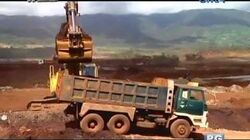
Born to be Wild Nickel mining sa Rio Tuba, Bataraza, Palawan
Born to be Wild: Nickel mining sa Rio Tuba, Bataraza, Palawan.
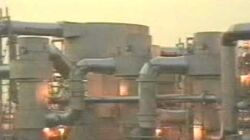
Inco Copper Cliff Smelter Complex Video, Sudbury Ontario
Inco Copper Cliff Smelter Complex Video, Sudbury Ontario.

Norilsk Nickel fleet - promo video
MMC Norilsk Nickel is a nickel and palladium mining and smelting company. Norilsk Nickel fleet - promo video.

The Mining and Smelting of Canadian Nickel Coniston ,Ontario
The Mining and Smelting of Canadian Nickel / Coniston, Ontario (1930's and 1940's).

Norilsk nickel Smelter
Master of Fire and Metal, Norilsk nickel Smelter.

The Sudbury Nickel Mine
The Sudbury Nickel Mine.

Modern Mining - How Eagle Mine produces nickel and copper
Modern Mining - How Eagle Mine produces nickel and copper.
Also see[]
- Will nickel, oil, uranium and copper ever run out?
- Soviet invasion of Greenland
- Operation Northern Norway
- Mirny Diamond Mine
- Minerals and fuel in central Africa
- 1970s energy crises
- Useful metals
- Mineral mining, smelting, processing and shipping videos!
- Today's OTL types of economies, societies and regimes
- Thoriated magnesium
- Thoriated magnesium (AKA- Mag-Thor)
- Manganese nodules
- Breda Folgore
- What is an 'alloy'?
- What is 'galvanizing'?
- Raney nickel
- Nickel aluminide
- Hastelloy/Haynes International
Outside links[]
- https://en.wikipedia.org/wiki/Nichrome
- http://www.sci-ed-ga.org/websites/gasef/images/pdf/light/section_13.pdf
- http://en.wikipedia.org/wiki/Nik%C3%ABl
- http://en.wikipedia.org/wiki/Nikel
- http://www.chemicool.com/elements/nickel.html
- http://www.chemicool.com/elements/uranium.html
- http://www.chemicool.com/elements/gold.html
- http://www.chemicool.com/elements/copper.html
- http://www.chemicool.com/elements/iron.html
- http://www.chemicool.com/elements/manganese.html
- https://en.wikipedia.org/wiki/Manganese_nodule
- http://oilprice.com/Finance/investing-and-trading-reports/Uranium-Prices-and-Mining-Stocks-Set-to-Rise-Beyond-2015.html
- http://www.uraniumseek.com/news/UraniumSeek/1175092156.php
- http://en.wikipedia.org/wiki/Vale_Limited
- http://en.wikipedia.org/wiki/Long_Harbour_Nickel_Processing_Plant
- http://en.wikipedia.org/wiki/Voisey%27s_Bay_Mine
- http://en.wikipedia.org/wiki/Norilsk_Nickel
- http://www.chemicool.com/elements/nickel.html
- http://geology.com/usgs/uses-of-nickel/
- http://www.nornik.ru/en/main
- http://www.chemicool.com/elements/titanium.html
- https://en.wikipedia.org/wiki/Manganese_nodule
- http://www.chemicool.com/elements/cobalt.html
- http://www.infomine.com/countries/mining-peru
- https://en.wikipedia.org/wiki/Mineral_industry_of_Peru
- https://www.azom.com/news.aspx?newsID=3866
- http://www.asminternational.org/documents/10192/1849770/ACFA9D7.pdf
- http://ww12.nidi.org/
- http://www.ias.ac.in/sadhana/Pdf2003Apr/Pe1064.pdf
- http://www.sciencedirect.com/science/article/pii/0001616085901397?via%3Dihub
- https://link.springer.com/article/10.1007%2FBF02717135
- https://en.wikipedia.org/wiki/Nickel_aluminide#IC-221M
- https://en.wikipedia.org/wiki/Kanthal_(alloy)
- http://www.kanthal.com
- http://www.resistancewire.com/Html/techinfo.htm
- http://www.sci-ed-ga.org/modules/materialscience/light/pdf/section_13.pdf
- https://web.archive.org/web/20050320175732/http://www.sci-ed-ga.org/modules/materialscience/light/pdf/section_13.pdf
- http://www.kanthal.com/en/products/
- http://www.vapingpost.com/2016/03/08/a-chemists-advice-dont-dry-burn-your-coil/%7Ctitle=A #https://www.misthub.com/blogs/vape-tutorials/113485637-tutorial-nichrome-vs-ni-200-vs-titanium-vs-kanthal-vs-stainless-steel-vape-wire
- https://en.wikipedia.org/wiki/Kanthal_(alloy)
- https://en.wikipedia.org/wiki/Nichrome
- https://en.wikipedia.org/wiki/Dental_amalgam_controversy
- https://en.wikipedia.org/wiki/Dental_restoration
- https://en.wikipedia.org/wiki/Nickel_aluminide#IC-221M
- https://www.wikiwand.com/en/Resistance_wire
- https://en.wikipedia.org/wiki/Constantan
- https://en.wikipedia.org/wiki/Nichrome
- http://www.sci-ed-ga.org/websites/gasef/images/pdf/light/section_13.pdf
- http://en.wikipedia.org/wiki/Nik%C3%ABl
- http://en.wikipedia.org/wiki/Nikel
- http://www.chemicool.com/elements/nickel.html
- http://www.chemicool.com/elements/uranium.html
- http://www.chemicool.com/elements/gold.html
- http://www.chemicool.com/elements/copper.html
- http://www.chemicool.com/elements/iron.html
- http://www.chemicool.com/elements/manganese.html
- https://en.wikipedia.org/wiki/Manganese_nodule
- http://oilprice.com/Finance/investing-and-trading-reports/Uranium-Prices-and-Mining-Stocks-Set-to-Rise-Beyond-2015.html
- http://www.uraniumseek.com/news/UraniumSeek/1175092156.php
- http://en.wikipedia.org/wiki/Vale_Limited
- http://en.wikipedia.org/wiki/Long_Harbour_Nickel_Processing_Plant
- http://en.wikipedia.org/wiki/Voisey%27s_Bay_Mine
- http://en.wikipedia.org/wiki/Norilsk_Nickel
- http://www.chemicool.com/elements/nickel.html
- http://geology.com/usgs/uses-of-nickel/
- http://www.nornik.ru/en/main
- http://www.chemicool.com/elements/titanium.html
- https://en.wikipedia.org/wiki/Manganese_nodule
- http://www.chemicool.com/elements/cobalt.html
- http://www.infomine.com/countries/mining-peru
- https://en.wikipedia.org/wiki/Mineral_industry_of_Peru
- https://www.azom.com/news.aspx?newsID=3866
- http://www.asminternational.org/documents/10192/1849770/ACFA9D7.pdf
- http://ww12.nidi.org/
- http://www.ias.ac.in/sadhana/Pdf2003Apr/Pe1064.pdf
- http://www.sciencedirect.com/science/article/pii/0001616085901397?via%3Dihub
- https://link.springer.com/article/10.1007%2FBF02717135
- https://en.wikipedia.org/wiki/Nickel_aluminide#IC-221M
- https://en.wikipedia.org/wiki/Kanthal_(alloy)
- http://www.kanthal.com
- http://www.resistancewire.com/Html/techinfo.htm
- http://www.sci-ed-ga.org/modules/materialscience/light/pdf/section_13.pdf
- https://web.archive.org/web/20050320175732/http://www.sci-ed-ga.org/modules/materialscience/light/pdf/section_13.pdf
- http://www.kanthal.com/en/products/
- http://www.vapingpost.com/2016/03/08/a-chemists-advice-dont-dry-burn-your-coil/%7Ctitle=A #https://www.misthub.com/blogs/vape-tutorials/113485637-tutorial-nichrome-vs-ni-200-vs-titanium-vs-kanthal-vs-stainless-steel-vape-wire
- https://en.wikipedia.org/wiki/Kanthal_(alloy)
- https://en.wikipedia.org/wiki/Nichrome
- https://en.wikipedia.org/wiki/Dental_amalgam_controversy
- https://en.wikipedia.org/wiki/Dental_restoration
- https://en.wikipedia.org/wiki/Nickel_aluminide#IC-221M
- https://www.wikiwand.com/en/Resistance_wire
- https://en.wikipedia.org/wiki/Constantan
